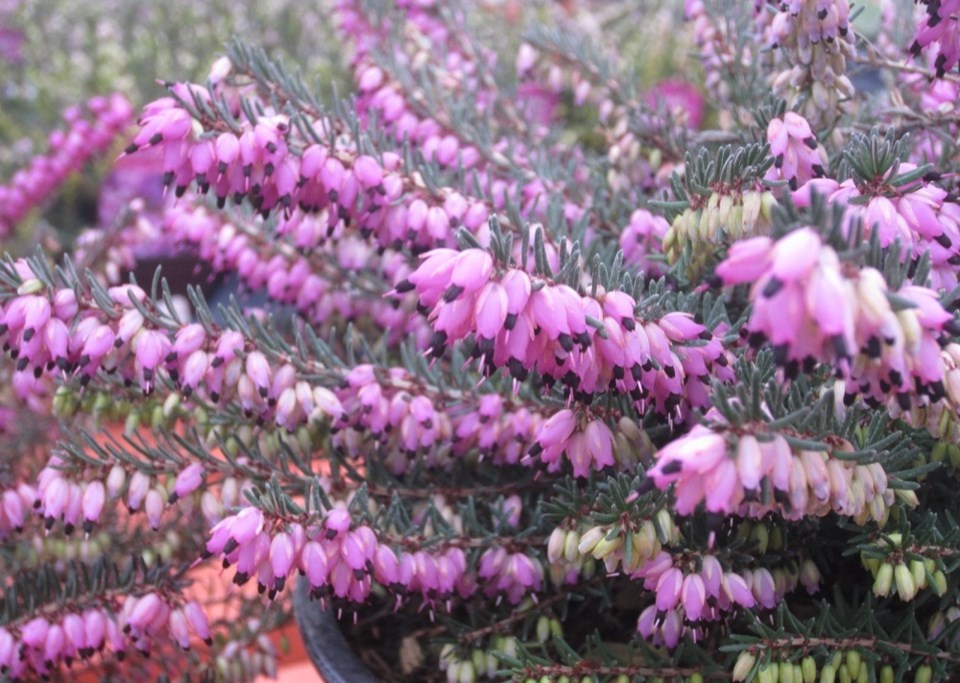Now that much of our brilliantly coloured fall foliage has disappeared thanks to recent strong winds, let’s add some long-lasting winter colour to our gardens for enjoyment well into spring.
Some of the most colourful plants, both in containers and garden beds, are winter-flowering heathers or heaths. Unfortunately, a very extreme cold spell last year froze out a significant number of these winter beauties.
There were, however, some other factors that contributed to those losses. Most folks are unaware that some varieties of heathers originate from various parts of the world. Many of us have Mediterranean and South African varieties in our gardens. Under normal conditions, they will survive our average winter cold spells, but their cold tolerance is limited to areas rated Zone 6b. When we experience extreme cold, with temperatures dipping to the Zone 6 or even the Zone 5 range, they simply cannot withstand that degree of cold.
The hardiest varieties, Erica carneas, are native to northern and western Europe. They are Zone 6 plants and will even tolerate some Zone 5 situations. Fortunately, these varieties are being grown by many local B.C. nurseries, and there is a wide selection of colours.
To ensure that our heathers have the best chance of surviving our more extreme weather, there are a few things we can do. Location is one of the main considerations.
It’s true that heathers love sunshine, but with our drier and warmer summers, they are best situated in a location with morning and early afternoon sun, followed by light shading from the extreme afternoon heat. It would also be ideal if they are planted in a spot sheltered from those cold outflow winds.
Good drainage is important too. Heathers have very fine root systems, and they do not like wet feet.
Sitting in poorly drained soil can cause not only root rot but also make them more susceptible to frost damage. The excessive rain we’ve experienced over the past few weeks will certainly have exposed any low, wet spots that we might have in our gardens. Avoid planting in those areas until the drainage situation is fixed. Heathers will always benefit from having fine fir or hemlock sawdust worked into their planting areas to improve the drainage and to encourage the development of new roots.
Before planting heathers, a gentle massage of their root balls will encourage those tiny white roots to quickly engage with their planting area. Like their blueberry cousins, heathers love water, but it must drain away quickly from their roots.
Winter heathers look best when planted in groupings of threes or fives. The reddish-purple varieties, like Erica carnea Kramer’s Red and E.c.Nathalie, look so much more attractive when contrasted with whites, like E. Silberschmelze or E.c.Springwood White. Even some of the great pinks, like E. Alice and E.c. Springwood Pink, make a more vibrant presentation when partnered with a white accent.
I love the golden foliaged varieties, like E. Eva Gold, with its dark pink flowers and E. Mary Helen.
My favourite, however, is E.c. Golden Starlet. It has a flat, mat-like habit, rich golden foliage and contrasting white flowers which bloom all winter long.
If you have very limited space or only have containers in which to enjoy them, some of the bi- and tri-coloured combinations are ideal. Erica Candy Stripe is a combination of E. Kramer’s Red and E. Alba. To really heighten the effect and to add a seasonal touch, add in a small golden cedar, like Thuja Jantar, some evergreen carex grass and a red berried wintergreen, like Gaultheria procumbens.
It's time to try winter heathers again for some precious garden colour this winter; but be sure to choose the hardier varieties and provide them with a protected location.
If we get some really nasty cold weather, either mulch your heathers or cover them with some N-Sulate fabric to keep them well protected.



